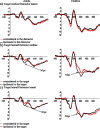Visual search and the N2pc in children
- PMID: 25678274
- PMCID: PMC4381109
- DOI: 10.3758/s13414-015-0833-5
Visual search and the N2pc in children
Abstract
While there is growing understanding of visual selective attention in children, some aspects such as selection in the presence of distractors are not well understood. Adult studies suggest that when presented with a visual search task, an enhanced negativity is seen beginning around 200 ms (the N2pc) that reflects selection of a target item among distractors. However, it is not known if similar selective attention-related activity is seen in children during visual search. This study was designed to investigate the presence of the N2pc in children. Nineteen children (ages 9-12 years) and 21 adults (ages 18-22 years) completed a visual search task in which they were asked to attend to a fixation surrounded by both a target and a distractor stimulus. Three types of displays were analyzed at parietal electrodes P7 and P8; lateral target/lateral distractor, lateral target/midline distractor, and midline target/lateral distractor. Both adults and children showed a significant increased negativity contralateral compared to ipsilateral to the target (reflected in the N2pc) in both displays with a lateral target while no such effect was seen in displays with a midline target. This suggests that children also utilized additional resources to select a target item when distractors are present. These findings demonstrate that the N2pc can be used as a marker of attentional object selection in children.
Figures



References
-
- Boehler CN, Tsotsos JK, Schoenfeld MA, Heinze H-J, Hopf J-M. Neural mechanisms of surround attenuation and distractor competition in visual search. The Journal of Neuroscience: The Official Journal of the Society for Neuroscience. 2011;31(14):5213–24. doi: 10.1523/JNEUROSCI.6406-10.2011. - DOI - PMC - PubMed
-
- Booth JR, Burman DD, Meyer JR, Lei Z, Trommer BL, Davenport ND, Mesulam MM. Larger deficits in brain networks for response inhibition than for visual selective attention in attention deficit hyperactivity disorder (ADHD) Journal of Child Psychology and Psychiatry, and Allied Disciplines. 2005;46(1):94–111. doi: 10.1111/j.1469-7610.2004.00337.x. - DOI - PubMed
MeSH terms
LinkOut - more resources
Full Text Sources
Other Literature Sources

